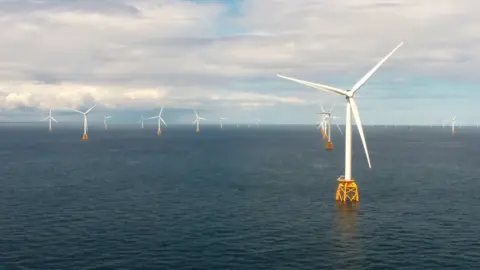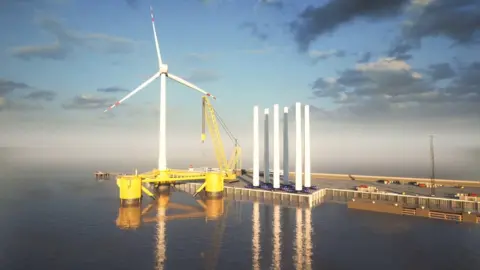Wind power: Go Forth and multiply
 BBC
BBC- Offshore wind is picking up pace, with prospects for tens of thousands of jobs if the potential is tapped, or a drop in offshore energy if it is not, according to a new report.
- Forth Ports is setting out its stall, with £40m investment in Leith Docks buying a large ship berth, strengthened storage, and a vast area for new supply and manufacturing jobs.
- Claiming at least 1,000 jobs can be created, the plan is to win for the Edinburgh seafront docks the new status of "greenport", for tax-free import and export activity.
They're familiar if you're in Aberdeen, on the horizon from Caithness, and will soon be appearing off the East Neuk of Fife. After that expect to see wind turbines out at sea, from Shetland to Lewis to Islay.
This is a vast engineering project that rivals North Sea oil and gas, or the building of the railways, and it's gathering pace, much of it over the horizon. It's related to the massive transition that edges closer to home, in electric vehicles and, before long, heating.
The UK has some of the best wind resource in the world, and it has taken an early lead - not in the technology but in the investment.
Scotland has quarter of the potential for all of Europe. Although England has taken the lead with shallower North Sea waters, the stronger winds in Scottish waters are becoming more of a focus.
There is a small and relatively old wind farm in the Solway Firth, Robin Rigg. Beatrice in the Moray Firth is the only large wind farm complete in Scottish waters, taking the total rating to nearly one gigawatt.
The Aberdeenshire coastline boasts the world's first floating array. Expect many more, because they are not constrained by the depth of the water or a difficult environment for piling, and can be located to the west of Scotland.
Several more arrays are under construction off the east coast, from Caithness to Aberdeenshire to Fife. And with the next generation, Scotland is on course to expand its offshore wind capability 11-fold during this decade.
Tram tracks
That will require far more quayside infrastructure than is currently ready. So it's announced today that Leith Docks, dominating the coast of Edinburgh, is to be transformed into Scotland's premier offshore energy park.
That's the plan from Forth Ports, which owns docks at Leith, Grangemouth, Rosyth, Dundee, the smaller Fife ports of Methil and Kirkcaldy and the vast Tilbury, at the Thames gateway to London.
These used to be publicly-owned. Through Forth Ports, they are now the property of five pension funds, delivering dividends for Australian builders, Canadian soldiers and Mounties, and English council workers.

The company is ploughing £40m into a new facility that will allow very large ships to dock at Leith for the unloading and loading of very long turbine blades, towers and nascelles, the gear boxes that can weigh 500 tonnes. Some floating turbines will be assembled at the 300 metre berth, visible from across the capital, for towing out to their anchorages.
This requires exceptionally strong land. Quays routinely take 12 tonnes per square metre. The concrete being poured on the new loading deck will take 60 tonnes. Impacted aggregate across a 35-acre site will take 150 tonnes.
According to Forth Ports chief executive Charles Hammond: "What matters is not just the supply chain, logistics, and load-out capability, but the ability to release 150 acres of land for back up, for manufacturing, for supply and local content, in the great opportunity Scotland has in offshore wind. This will be one of the leading sites in Scotland for offshore wind".
Sugar silos and other dockland buildings are already being demolished. This is not the most productive dockland anyway, under-developed because Leith is not an attractive port for getting goods in or out by road, least of all with tram tracks being laid.
Towering blades
Leith was home to pioneering, but now stalled, work on wave power. That Pelamis shed is now the focus of plans for a film studio. Nearby is a tower where an Edinburgh firm is pioneering 'Gravitricity' - storing excess power at times of low demand by winding up large blocks of concrete, then releasing their energy when it's wanted.
Is there demand for big manufacturing on that newly-cleared land? Scotland has not yet given up on its long-frustrated hopes of a turbine blade factory. England got there earlier, because that's where the orders were, though it was German-Spanish, Danish and US companies that dominated the technology.
Two decades after the first British offshore turbines were put in the sea off Northumberland, there are now more than 2,200 turbines, and the largest ones are four times bigger.
The blades get longer and more sophisticated, and demand is growing. Where a turbine 10 years ago might deliver 1.5 megawatts (on average, when the wind blows, able to power 300 to 400 homes), GE is making them at 12 MW.

Siemens-Gamesa expects to install its first 14 MW turbine this year, with a rotor diameter of 222 metres. (With their towers, four of them on top of each other would be higher than a Munro mountain.) Don't be surprised if they reach 20 MW.
Floating turbines are smaller. The technology is less advanced. It was developed in Norway, but these carry a renewed hope that Scotland could get in at the start of manufacturing the floating platforms. There are export possibilities, as both the US and Japan will look to floating turbines due to these countries' deeper coastal waters.
But to compete with tooled-up yards elsewhere, they're going to have to get to a big scale and high productivity fast. These wind farms are costing billions of pounds each, but pricing is fiercely competitive.
High turbines, high stakes
And that's where jobs come in. Forth Ports estimates there should be 1,000 long-term jobs coming with its investment, and 2,000 could be supported indirectly.
It is bidding for the Firth of Forth to become a multi-centre "greenport". That is the compromise scheme from the UK and Scottish governments to designate industrial sites to import and export without paying national tax and with reduced planning controls.
Ministers at Holyrood insisted Scottish freeports, a UK government initiative, nevertheless have to be for green jobs. They are some months behind England in deciding which places are to benefit - bearing in mind that freeports are usually found to be a way of displacing jobs rather than creating new ones.
A report from Robert Gordon University today tots up the prospects across the UK, in a modelling of the decline of oil and gas and the rise of offshore wind, carbon capture and hydrogen production.
That offshore energy sector could increase to as many as 220,000 jobs by the end of this decade, with oil and gas declining from four-fifths to a third, and many of its workers having highly transferrable skills.
For the UK to meet its target of producing 40 gigawatts of energy from offshore wind by 2030, the Aberdeen academics reckon 2,500 new wind turbines will have to be installed - the equivalent of one new turbine each weekday for nine years.
With around 160,000 people currently directly and indirectly employed in the UK offshore energy sector, the report predicts this could grow to 200,000 or even 220,000 in the best case scenario over the period.
But if oil and gas decline faster and there isn't as much activity as currently planned, that figure could fall to 140,000.
That's a big variation. In this transition, the stakes are high. Scottish industry has some catching up to do, and probably needs more collaboration within the private sector and public agencies to put all that potential to work.
